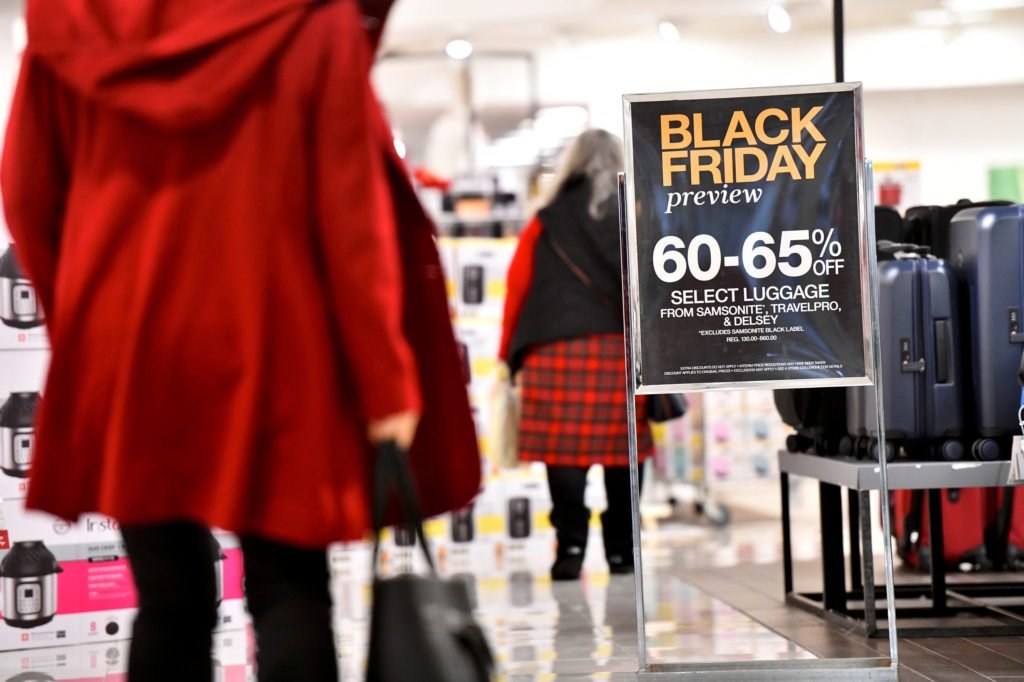Fewer promotions, lesser crowds and online deals create a muted response to one of the biggest retail days of the year.
Black Friday, traditionally the busiest and most important day of the year for retailers, is in the books. While final results are not likely to emerge until early next year, there are some initial clues as to who is having the best holiday.
Among the early trends coming into focus are fewer promotions and thinner crowds compared with pre-pandemic Black Fridays. Demand has been brisk, however, and shopping appears to be more spread out than in the past.
Shoppers returned to stores on Black Friday this year but traffic remained well below pre-pandemic levels, according to Sensormatic Solutions.
Visits to stores and shopping centres climbed 48 per cent from a year ago while trailing 2019 traffic by 28 per cent, Sensormatic said in a report on Saturday. One reason this year’s gain was not larger is that retailers spread out traffic peaks by starting holiday deals early, said Brian Field, senior director of global retail consulting at Sensormatic.
“Everybody started earlier and, most importantly, the shopper started earlier,” he said. “Going back to pre-pandemic times, the holiday season very clearly started the week of Black Friday. You could bank on it.”
During the holiday season as a whole this year, in-store visits are expected to lag 2019 levels by only 10 per cent to 15 per cent, said Sensormatic. Despite Covid-19 concerns, research points to consumers prioritising in-store shopping to avoid potential shipping delays amid well-publicised logjams in the global supply chain, Mr Field said.
Meanwhile, online spending totalled $8.9 billion on Black Friday, a number that was at the low end of expectations and slightly less than last year, according to the latest tally from the Adobe Digital Economy Index.
“For the first time ever, Black Friday saw a reversal of the growth trend of past years,” Vivek Pandya, lead analyst at Adobe Digital Insights, said in a report on US e-commerce trends. Last year, online Black Friday spending hit $9bn.
This year, sales on Thanksgiving Day were flat at $5.1bn, and the sluggish two-day performance was a “sign that consumers started to shift their spending to earlier in the season, responding to promotions and deals from retailers that started in October”, Adobe said.
Consumers were expected to spend $4.5bn to $5.1bn online on Saturday. Adobe predicted purchases of $10.2bn to $11.3bn on November 29, or Cyber Monday, which the firm said, is set to be the biggest online shopping day of the year. Adobe reiterated its prediction of $207bn in consumer spending during the holiday season as a whole.
“Black Friday still remains a major online shopping day, but the surge in online shopping is coming from the less marketed days of the season,” said Taylor Schreiner, director at Adobe Digital Insights, noting that shoppers started with their purchases since late October.
Toys and cooking items were the top sellers for the day, Adobe said. With shoppers still concerned about the pandemic, kerbside pickup has risen 78 per cent from two years ago, it said.
According to Adobe, electronics and video games dominated the list of top-selling products bought online. Items included televisions made by Samsung and Vizio, Oculus Quest 2 – Meta’s virtual reality headset – and video game titles such as Fifa 22 from Electronic Arts and Ubisoft Entertainment’s Far Cry 6. Most-purchased toys included Legos and Rainbocorns.
Consumers are increasingly financing their holiday shopping with buy-now-pay-later options and instalment plans for their purchases.
On Thanksgiving Day, purchases in the US using Klarna, one such app offering instalment payments, rose 124 per cent from a year ago.
According to data from Salesforce.com, shoppers used BNPL options on 8 per cent of all purchases in the past couple of days – up 31 per cent from the previous year.
“Generally, because of rising costs, people are willing to pay more for a particular item,” said Rob Garf, vice president of retail at Salesforce. “They want to buy early, but on the other hand, they are trying to be prudent with their budget.”
With Covid-19 still lingering – and a new variant emerging – retailers have largely eschewed offers that would require customers to pack into stores to get them. But that does not mean Black Friday sales have completely disappeared, said Poonam Goyal, Bloomberg Intelligence retail analyst.
“What we don’t have again is doorbusters,” she said. “All the deals that are available in store are largely available online, which seems that you can go out if you want to enjoy the experience of Black Friday shopping but alternatively you can find everything still online from your home without stepping outside. I think online shopping will be a much bigger deal.”
Jeff Gennette, chief executive at Macy’s, said he did not see Black Friday foot traffic bouncing back to pre-pandemic levels this year. Traffic at stores remained below what it was in 2019, he said. More of those who go in are actually making a purchase, however.
Like the rest of the industry, staffing has been a challenge.
“We’ve got some stores in great shape and some stores that are really lean,” Mr Gennette said last week.
The department store chain said earlier this month it would raise the minimum wage to $15 an hour by May. Because of seasonal challenges, that pay boost has already gone into effect in more than 100 stores for the Christmas hiring season.
Hiring has improved, “but we still have some gaps and open jobs”, he said. “We’re mitigating that by offering spot bonuses or premium pay for weekends. We’re offering our colleagues opportunity for overtime and working six days.”
(Except for the headline, this story has not been edited by The Finance World staff and is published from a syndicated feed.)


